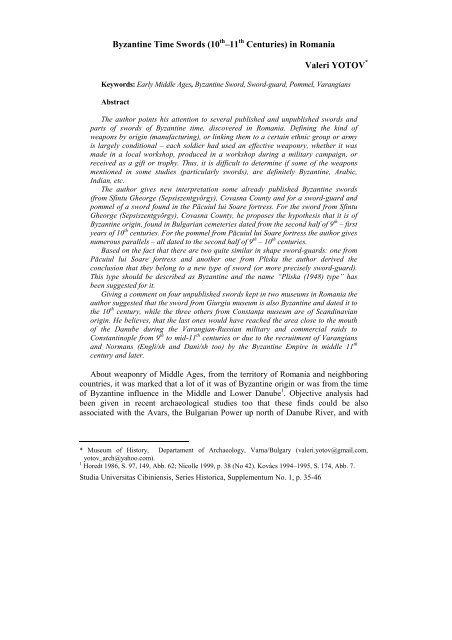Download - Facultatea de Științe Socio-Umane - Universitatea ...
Download - Facultatea de Științe Socio-Umane - Universitatea ...
Download - Facultatea de Științe Socio-Umane - Universitatea ...
You also want an ePaper? Increase the reach of your titles
YUMPU automatically turns print PDFs into web optimized ePapers that Google loves.
Byzantine Time Swords (10 th –11 th Centuries) in Romania<br />
Studia Universitas Cibiniensis, Series Historica, Supplementum No. 1, p. 35-46<br />
Valeri YOTOV *<br />
Keywords: Early Middle Ages, Byzantine Sword, Sword-guard, Pommel, Varangians<br />
Abstract<br />
The author points his attention to several published and unpublished swords and<br />
parts of swords of Byzantine time, discovered in Romania. Defining the kind of<br />
weapons by origin (manufacturing), or linking them to a certain ethnic group or army<br />
is largely conditional – each soldier had used an effective weaponry, whether it was<br />
ma<strong>de</strong> in a local workshop, produced in a workshop during a military campaign, or<br />
received as a gift or trophy. Thus, it is difficult to <strong>de</strong>termine if some of the weapons<br />
mentioned in some studies (particularly swords), are <strong>de</strong>finitely Byzantine, Arabic,<br />
Indian, etc.<br />
The author gives new interpretation some already published Byzantine swords<br />
(from Sfintu Gheorge (Sepsiszentgyörgy), Covasna County and for a sword-guard and<br />
pommel of a sword found in the Păcuiul lui Soare fortress. For the sword from Sfintu<br />
Gheorge (Sepsiszentgyörgy), Covasna County, he proposes the hypothesis that it is of<br />
Byzantine origin, found in Bulgarian cemeteries dated from the second half of 9 th – first<br />
years of 10 th centuries. For the pommel from Păcuiul lui Soare fortress the author gives<br />
numerous parallels – all dated to the second half of 9 th – 10 th centuries.<br />
Based on the fact that there are two quite similar in shape sword-guards: one from<br />
Păcuiul lui Soare fortress and another one from Pliska the author <strong>de</strong>rived the<br />
conclusion that they belong to a new type of sword (or more precisely sword-guard).<br />
This type should be <strong>de</strong>scribed as Byzantine and the name “Pliska (1948) type” has<br />
been suggested for it.<br />
Giving a comment on four unpublished swords kept in two museums in Romania the<br />
author suggested that the sword from Giurgiu museum is also Byzantine and dated it to<br />
the 10 th century, while the three others from Constanţa museum are of Scandinavian<br />
origin. He believes, that the last ones would have reached the area close to the mouth<br />
of the Danube during the Varangian-Russian military and commercial raids to<br />
Constantinople from 9 th to mid-11 th centuries or due to the recruitment of Varangians<br />
and Normans (Engli/sh and Dani/sh too) by the Byzantine Empire in middle 11 th<br />
century and later.<br />
About weaponry of Middle Ages, from the territory of Romania and neighboring<br />
countries, it was marked that a lot of it was of Byzantine origin or was from the time<br />
of Byzantine influence in the Middle and Lower Danube 1 . Objective analysis had<br />
been given in recent archaeological studies too that these finds could be also<br />
associated with the Avars, the Bulgarian Power up north of Danube River, and with<br />
* Museum of History, Departament of Archaeology, Varna/Bulgary (valeri.yotov@gmail.com,<br />
yotov_arch@yahoo.com).<br />
1 Horedt 1986, S. 97, 149, Abb. 62; Nicolle 1999, p. 38 (No 42). Kovács 1994–1995, S. 174, Abb. 7.





